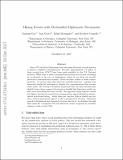Mining events with declassified diplomatic documents
Author(s)
Mazumder, Rahul
DownloadPublished version (1.147Mb)
Open Access Policy
Open Access Policy
Creative Commons Attribution-Noncommercial-Share Alike
Terms of use
Metadata
Show full item recordAbstract
Since 1973, the U.S. State Department has been using electronic record systems to preserve classified communications. Recently, approximately 1.9 million of these records from 1973–77 have been made available by the U.S. National Archives. While some of these communication streams have periods witnessing an acceleration in the rate of transmission, others do not show any notable patterns in communication intensity. Given the sheer volume of these communications, far greater than what had been available until now, scholars need automated statistical techniques to identify the communications that warrant closer study. We develop a statistical framework that can identify from a large corpus of documents a handful that historians would consider more interesting. Our approach brings together techniques from nonparametric signal estimation, statistical hypothesis testing and modern optimization methods—leading to a set of tools that help us identify and analyze various geometrical aspects of the communication streams. Dominant periods of heightened activities, as identified through these methods, correspond well with historical events recognized by standard reference works on the 1970s.
Date issued
2020-12Department
Sloan School of ManagementJournal
Annals of Applied Statistics
Publisher
Institute of Mathematical Statistics
Citation
Gao, Yuanjun et al. “Mining events with declassified diplomatic documents.” Annals of Applied Statistics, 14, 4 (December 2020): 1699 - 1723 © 2020 The Author(s)
Version: Original manuscript
ISSN
1941-7330
1932-6157